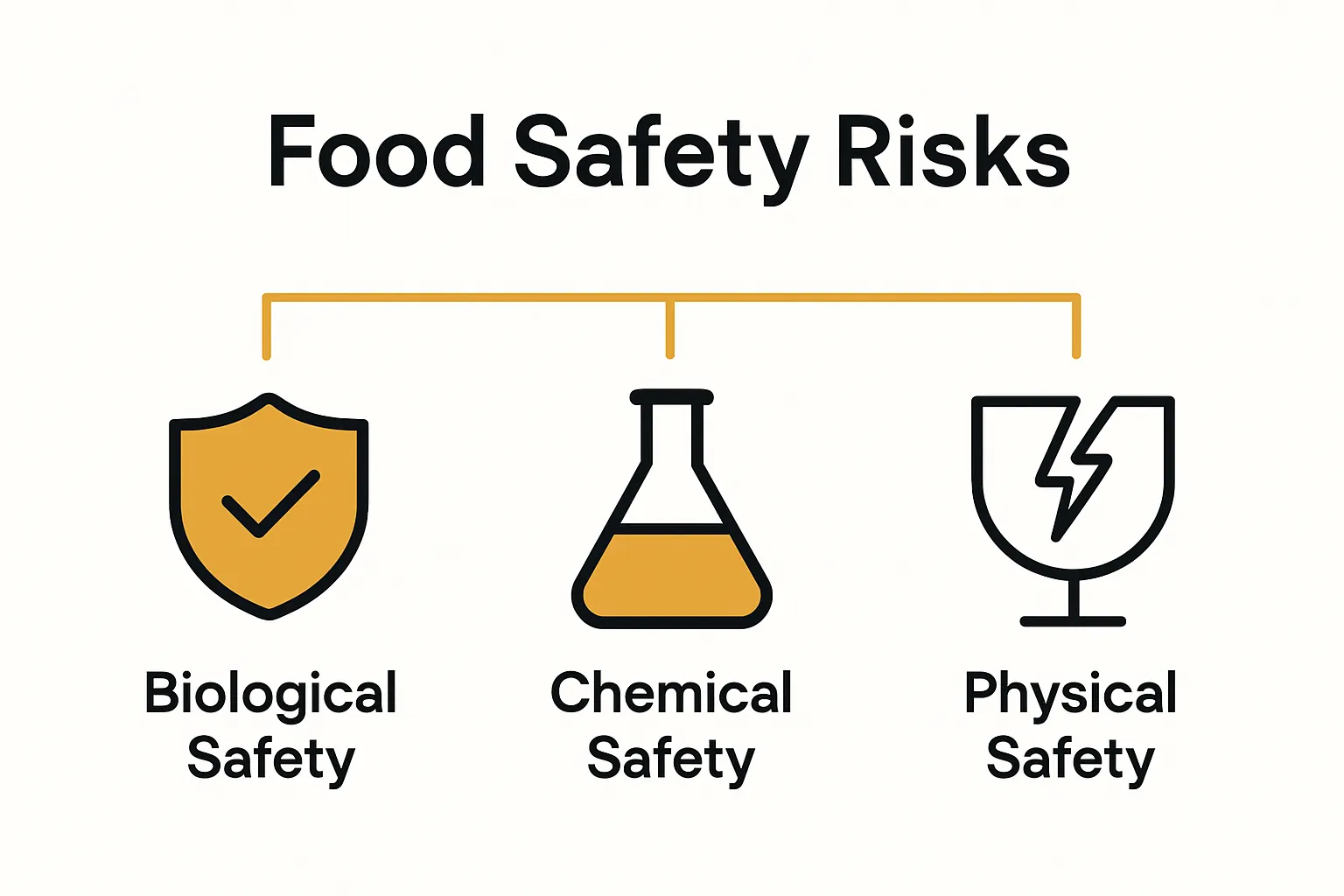Food safety in Canada is more than just a list of rules. Over 4 million Canadians get sick from foodborne illnesses every year. Most people expect science and strict checks to guarantee their food is safe. Yet even the best-equipped kitchens and the most cautious food companies can be caught off guard if they miss a single step. What really keeps that risk in check is a constantly evolving safety system—and that surprises most people.
Table of Contents
- What Are Food Safety Standards In Canada?
- Why Food Safety Standards Matter For Your Business
- How Food Safety Standards Work In Canada
- Key Concepts Of Food Safety Standards And Compliance
Quick Summary
| Takeaway | Explanation |
|---|---|
| Understand food safety standards are crucial | They protect public health by ensuring the safety and quality of food products. |
| Compliance prevents legal and financial troubles | Noncompliance can lead to hefty fines, lawsuits, and potential business closure. |
| Implement robust safety management systems | Use HACCP principles to manage risks and ensure food safety at all production stages. |
| Traceability is essential for accountability | Maintain detailed records to quickly identify issues and support product recalls when necessary. |
| Safety standards enhance consumer trust and reputation | Companies prioritizing food safety gain a competitive edge and foster stronger customer relationships. |
What are Food Safety Standards in Canada?
Food safety standards in Canada represent a comprehensive system of regulations, guidelines, and practices designed to protect public health by ensuring the safety, quality, and integrity of food products throughout the entire supply chain. These standards are meticulously developed and enforced by multiple government agencies, with Health Canada playing a central role in establishing and monitoring food safety protocols.
Core Purpose of Food Safety Standards
At their fundamental level, Canadian food safety standards aim to prevent foodborne illnesses, contamination, and potential health risks associated with food production, processing, distribution, and consumption. These standards encompass multiple critical dimensions that ensure comprehensive protection for consumers:
The table below summarizes the core types of hazards addressed by Canadian food safety standards and provides examples for each category.
| Hazard Type | Description | Example(s) |
|---|---|---|
| Biological | Contamination from bacteria, viruses, parasites, or fungi | Salmonella, E. coli, norovirus |
| Chemical | Harmful chemical residues or additives in food | Pesticides, cleaning agents, allergens |
| Physical | Presence of foreign objects or physical contaminants | Glass, metal, or plastic fragments |

- Biological Safety: Preventing bacterial, viral, and parasitic contamination
- Chemical Safety: Monitoring and limiting harmful chemical residues and additives
- Physical Safety: Ensuring no foreign objects or physical contaminants are present in food products
Regulatory Framework and Enforcement
Canada’s food safety regulatory framework involves collaboration between federal, provincial, and territorial governments. Key agencies like the Canadian Food Inspection Agency (CFIA) work together to develop, implement, and enforce stringent food safety regulations. Retailers, manufacturers, and food service providers must comply with these standards, which cover everything from ingredient sourcing and manufacturing processes to packaging, storage, and transportation.
Businesses operating in the food sector must implement comprehensive food safety management systems, such as Hazard Analysis Critical Control Point (HACCP) principles. These systematic approaches help identify potential hazards, establish preventive measures, and maintain rigorous documentation to demonstrate compliance with national food safety standards.
By Understanding Food Safety Regulations Canada, businesses can protect consumer health, maintain public trust, and contribute to Canada’s reputation for high-quality, safe food products.
Why Food Safety Standards Matter for Your Business
Food safety standards are not just regulatory requirements but critical business strategies that directly impact a company’s reputation, financial stability, and long-term success. For businesses in the food industry, understanding and implementing rigorous safety protocols is a fundamental aspect of responsible operations.
Legal and Financial Protection
Noncompliance with food safety standards can result in severe consequences that extend far beyond simple regulatory penalties. Canadian Food Inspection Agency reports demonstrate that businesses facing food safety violations can encounter significant financial risks:
- Substantial Fines: Regulatory infractions can lead to monetary penalties ranging from thousands to hundreds of thousands of dollars
- Legal Liability: Potential lawsuits from consumers experiencing foodborne illnesses
- Business Closure: Repeated or severe violations might result in temporary or permanent business shutdowns
Reputation and Consumer Trust
In the age of social media and instantaneous communication, a single food safety incident can devastate a brand’s reputation. Consumers are increasingly informed and selective about the businesses they support. Demonstrating a commitment to food safety standards becomes a competitive advantage. Companies that prioritize transparent, stringent safety protocols build stronger relationships with customers, differentiate themselves in the marketplace, and create a reputation for reliability and professionalism.
Moreover, many retailers and distributors now require suppliers to demonstrate robust food safety management systems as a prerequisite for doing business. By Understanding Food Packaging Regulations Canada, businesses can ensure they meet these increasingly stringent supply chain requirements and expand their market opportunities.
How Food Safety Standards Work in Canada
Food safety standards in Canada operate through a sophisticated, multi-layered system designed to ensure comprehensive protection across the entire food supply chain. This intricate framework involves collaboration between federal, provincial, and municipal authorities to create and enforce robust regulations that safeguard public health.
This table outlines the primary roles and responsibilities of Canadian food safety regulatory agencies to help clarify their distinct functions in the system.
| Agency Name | Core Responsibilities |
|---|---|
| Health Canada | Develops food safety policies and standards |
| Canadian Food Inspection Agency (CFIA) | Enforcement, inspections, and compliance monitoring |
| Provincial & Territorial Governments | Supplement regulation and perform local oversight |
| Municipal Authorities | Enforce safety standards at the local retail and food service level |
Regulatory Agencies and Their Roles
Health Canada plays a pivotal role in developing food safety policies and standards. The Canadian Food Inspection Agency (CFIA) serves as the primary enforcement body, responsible for verifying compliance and conducting inspections across various food sectors. These agencies work together to create a comprehensive system that covers multiple aspects of food safety:
- Policy Development: Creating science-based guidelines and regulations
- Risk Assessment: Identifying potential health hazards in food production
- Compliance Monitoring: Conducting regular inspections and audits
- Enforcement: Implementing penalties for regulatory violations
Implementation of Safety Protocols
Businesses in the food industry must adhere to stringent protocols that encompass every stage of food production. The Hazard Analysis Critical Control Point (HACCP) system is a cornerstone of these safety standards, requiring businesses to:
- Identify potential biological, chemical, and physical hazards
- Establish critical control points in the production process
- Implement preventive measures
- Maintain detailed documentation of safety procedures
By Understanding Food Labeling Requirements, businesses can further ensure compliance and transparency in their food safety approaches. The system is designed to be proactive, focusing on preventing contamination and potential health risks before they can impact consumers.
The Canadian food safety framework is dynamic, continuously evolving to address emerging challenges, technological advancements, and new scientific understanding of food-related health risks. This adaptive approach ensures that food safety standards remain responsive to changing industry practices and consumer needs.
Key Concepts of Food Safety Standards and Compliance
Food safety standards and compliance represent a comprehensive approach to managing risks and ensuring the highest quality of food products throughout the production and distribution process. Understanding these key concepts is crucial for businesses operating in the food industry to maintain public health and regulatory requirements.
Risk Management and Hazard Prevention
Risk management is the foundational principle of food safety standards. Canadian Food Inspection Agency emphasizes a systematic approach to identifying, evaluating, and controlling potential hazards that could compromise food safety:
- Biological Hazards: Bacteria, viruses, parasites, and other microorganisms
- Chemical Hazards: Pesticides, cleaning agents, allergens, and toxic substances
- Physical Hazards: Foreign objects like glass, metal, or plastic fragments
Traceability and Documentation
Traceability is a critical component of food safety compliance that enables businesses to track food products through every stage of the supply chain. Comprehensive documentation allows for quick identification and resolution of potential safety issues. This system requires businesses to maintain detailed records that can:

- Identify the origin of ingredients
- Track product movement
- Enable rapid product recalls if necessary
- Provide transparent accountability
By Understanding Food Packaging Regulations Canada, businesses can further enhance their traceability and documentation processes, ensuring a more robust food safety management system.
The ultimate goal of these key concepts is to create a proactive approach to food safety that prioritizes prevention over reaction. Businesses that thoroughly understand and implement these principles can protect consumer health, minimize potential risks, and demonstrate a commitment to quality and safety in their operations.
Elevate Your Retail Food Safety with a Trusted Canadian Partner
If you are a retailer looking to navigate the complex world of Canadian food safety standards, you know the pressure of meeting compliance while keeping your brand safe and strong. The article covers the challenges of hazard management, traceability, and meticulous documentation—just a few of the many responsibilities weighing on your business. You need a partner who understands these critical demands and who can help you stay ahead of regulatory risks and market expectations.

Choose Space Man as your go-to Canadian freeze dried candy manufacturer and distributor. We offer not only high-quality products but also private labeling and co-packing services designed for retailers who care about compliance, safety, and building lasting consumer trust. Learn how our full-service solutions can protect your reputation, streamline your food safety documentation, and open new opportunities for your brand. Visit our homepage to get started. With regulatory changes moving fast, now is the time to secure a committed partner who can help you lead in food safety and customer confidence.
Frequently Asked Questions
What are the main food safety standards retailers must follow in Canada?
Retailers in Canada must adhere to food safety standards that ensure the safety, quality, and integrity of food throughout the supply chain. These include protocols for biological, chemical, and physical safety to prevent contamination and foodborne illnesses.
How do retailers ensure compliance with food safety regulations?
Retailers ensure compliance by implementing comprehensive food safety management systems, such as Hazard Analysis Critical Control Point (HACCP) principles, which help identify potential hazards and establish preventive measures throughout the food handling process.
Why are food safety standards important for a retailer’s reputation?
Food safety standards are critical for maintaining consumer trust and brand reputation. A single food safety incident can lead to negative publicity and loss of credibility, hence, adherence to these standards serves as a competitive advantage.
What legal consequences can retailers face for noncompliance with food safety standards?
Retailers that fail to comply with food safety standards may face substantial fines, legal liability from consumers affected by foodborne illnesses, and potential business closure due to repeated violations.

